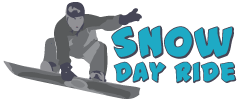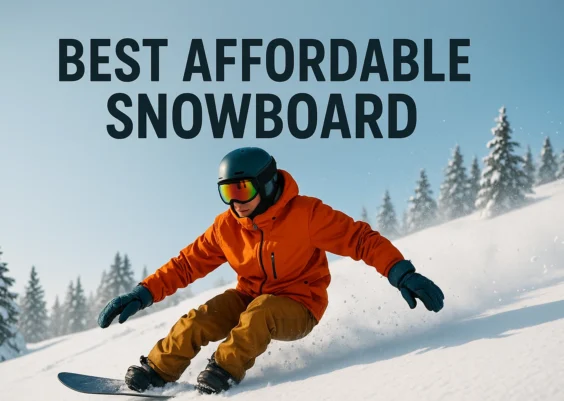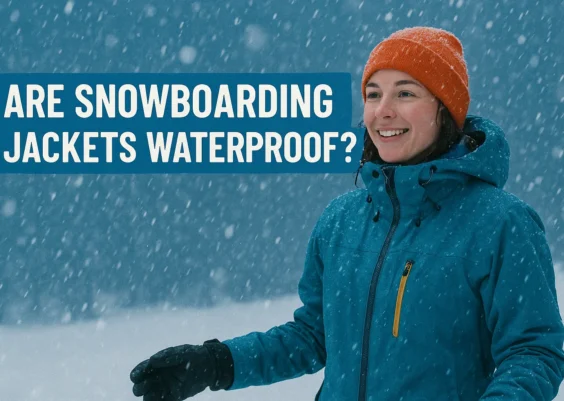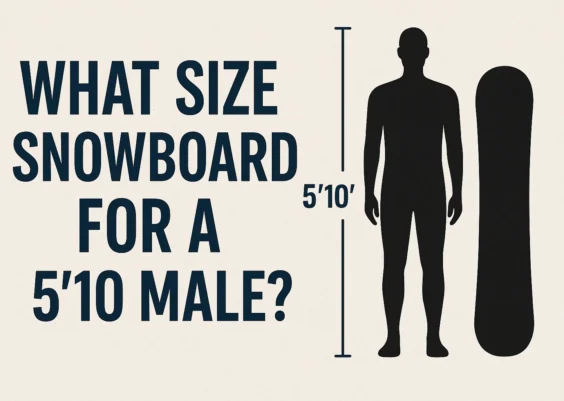Quick Facts
- A snowboard should usually reach between your chin and nose when stood upright.
- Weight is the most important factor because it affects how the board flexes and responds.
- Boot size controls width. For example, US Men’s size 8–9 fits a 245–255 mm waist width.
- Shorter boards are easier to control and better for beginners.
- Longer boards give more speed and stability, especially in powder or at high speeds.
How tall should your snowboard be compared to you? The quick answer is that most boards should stand somewhere between your chin and nose when upright. That’s the basic rule many riders follow, and it works as a starting point. But choosing the right length is not that simple.
Height alone doesn’t tell the full story. Your weight, boot size, ability level, and riding style all play major roles. A board that’s too long or too short can affect control, speed, and safety. So, while the chin-to-nose rule helps, there’s more to learn if you want the perfect fit.
Quick Tips for Choosing Snowboard Length
- Start with the chin-to-nose rule: Most boards should stand between your chin and nose.
- Check the weight chart first: If you’re heavy for your height, size up 2–3 cm. If light, size down.
- Match boot size to width: Keep waist width within the 240–270 mm range based on US boot size.
- Adjust for style: Shorter for park/freestyle, longer for powder/freeride.
- Beginners: Go 3–5 cm shorter for easier turns.
- Advanced riders: Size up for speed, carving, and powder float.
- Try before buying: If possible, demo boards to see what feels most comfortable.
How Tall Should Your Snowboard Be Compared to You
The right snowboard length is not fixed for everyone. The chin-to-nose rule gives a quick range, but weight, boot size, riding style, and ability level can change the best choice by several centimeters. Getting this balance right means better control, smoother turns, and less fatigue. Let’s go deeper into each factor so you can fine-tune your snowboard size.
The Chin-to-Nose Rule
When stood upright, most boards should reach between your chin and nose. For example, a rider who is 170 cm tall will usually choose a board between 150–160 cm. This works for most beginners and casual riders.
Exception: Taller riders with lighter weight can size down by 2–3 cm for easier control. Heavier riders can size up to maintain stability.
Why Weight Matters More Than Height
Snowboard companies publish recommended weight ranges for every board size. If you’re too heavy for a shorter board, it can feel unstable and wash out during turns. If you’re too light for a longer board, it feels stiff and hard to maneuver.
- A 155 cm board often fits riders around 120–150 lbs (54–68 kg).
- A 160 cm board may suit riders in the 150–180 lbs (68–82 kg) range.
- Riders above 200 lbs (90+ kg) often need boards 165 cm+ for proper support.
Recommended Weight Ranges from Snowbaord Companies
| Snowboard Brand | Publish Weight Range |
|---|---|
| Arbor | YES |
| Bataleon | YES |
| Burton | YES |
| Capita | YES |
| DC | NO |
| Endeavor | YES |
| GNU | YES |
| Jones | YES |
| K2 | YES |
| Lib Tech | YES |
| Never Summer | YES (as of 2025) |
| Nidecker | YES |
| Nitro | YES |
| Ride | YES |
| Rome | YES |
| Rossignol | YES |
| Salomon | YES |
Tip: If your weight sits at the top end of a board’s range, size up 2–3 cm.
Boot Size and Board Width
Boot size determines how wide your snowboard should be. A mismatch causes drag or sluggish turns.
- US Men’s 7–8: Board waist width 240–250 mm.
- US Men’s 9–10: Board waist width 250–260 mm.
- US Men’s 11–12: Board waist width 260–270 mm.
- US Men’s 13+: Board waist width 270 mm+ (wide board).
Exception: Freestyle riders with large boots sometimes use narrower boards with reduced toe/heel overhang for faster edge changes, but this requires careful setup.
Adjustments for Riding Style
- Freestyle: Choose 2–3 cm shorter than standard. Example: A 175 cm rider might ride 152–155 cm for park tricks.
- Freeride / Powder: Choose 2–5 cm longer than standard for float and stability. Example: That same rider could ride 160–162 cm for freeride.
- All-Mountain: Stick close to the standard range (chin to nose).
Skill Level Considerations
- Beginners: Boards 3–5 cm shorter than standard make turns easier and reduce edge catches.
- Intermediate: Stay within the chin-to-nose range for balance.
- Advanced: Size up for speed, carving, and off-piste performance.
Tip: If you ride mostly in the park, go shorter. If you ride mostly powder or high-speed groomers, go longer.
Snowboard Size Chart
Charts make sizing easier. Use your weight first, then check your height as a secondary guide. Here are the standard recommendations.
Men’s Snowboard Size Chart
| Rider Weight (lbs) | Rider Weight (kg) | Recommended Board Length (cm) |
|---|---|---|
| 90–120 | 41–54 | 140–148 |
| 120–150 | 54–68 | 147–155 |
| 150–180 | 68–82 | 154–162 |
| 180–210 | 82–95 | 160–167 |
| 210–250 | 95–113 | 165–172 |
| 250+ | 113+ | 170–180+ |
Women’s Snowboard Size Chart
| Rider Weight (lbs) | Rider Weight (kg) | Recommended Board Length (cm) |
|---|---|---|
| 80–110 | 36–50 | 135–143 |
| 110–140 | 50–64 | 141–149 |
| 140–170 | 64–77 | 147–155 |
| 170–200 | 77–91 | 153–160 |
| 200+ | 91+ | 158–165+ |
Youth Snowboard Size Chart
| Rider Weight (lbs) | Rider Weight (kg) | Recommended Board Length (cm) |
|---|---|---|
| 40–60 | 18–27 | 100–115 |
| 60–80 | 27–36 | 110–125 |
| 80–100 | 36–45 | 120–135 |
| 100–120 | 45–54 | 130–145 |
Snowboard Width Chart (By Boot Size)
| US Men’s Boot Size | Recommended Waist Width (mm) |
|---|---|
| 6–7 | 235–245 |
| 8–9 | 245–255 |
| 10 | 255–260 |
| 11 | 260–265 |
| 12 | 265–270 |
| 13+ | 270+ |
Tip: If your boots hang over the edge more than 1.5 cm, you may need a wider board.
Comparison: Long vs. Short Snowboards
| Feature | Long Snowboards (e.g., 165 cm) | Short Snowboards (e.g., 150 cm) |
|---|---|---|
| Speed & Stability | Stable at high speeds, less chatter | Less stable at speed, better for slower rides |
| Carving Power | Longer edge contact = smoother carves | Quicker edge-to-edge but less grip |
| Powder Riding | Floats better in deep snow | Sinks more, requires extra effort |
| Maneuverability | Slower, wider turns | Quick, agile turns, easier to control |
| Tricks & Spins | Harder to spin and press | Spins faster, easier for park tricks |
| Beginner Use | Can feel stiff and hard to control | More forgiving and playful |
| Best For | Freeride, heavy riders, high-speed carving | Beginners, park riders, playful style |
Tip: Size up 2–5 cm for freeride/powder. Size down 2–3 cm for freestyle/park.
FAQs
How do I know if my snowboard is too short or too long?
If it feels unstable at speed, it’s too short. If it’s hard to turn or feels stiff, it’s too long. The right length balances control with stability.
Should beginners go shorter or longer?
Beginners should pick a board 3–5 cm shorter than standard. A shorter board is easier to turn, less punishing for mistakes, and helps build confidence faster.
Does weight matter more than height?
Yes. Weight determines how the board flexes and performs. Two riders with the same height but different weights may need boards several centimeters apart to ride comfortably.
Can one snowboard work for both park and powder?
Yes, but it’s a compromise. All-mountain boards balance both styles. They’re usually sized within the chin-to-nose range, making them versatile without being perfect for one terrain.
Snowboard sizing is not just about height. The best board length depends on your weight, boot size, riding style, and skill level. Charts give a reliable starting point, but personal comfort matters most. The right snowboard should feel stable, responsive, and enjoyable for the way you ride. When you choose a board that fits you instead of just following a rule, every run becomes easier and more fun.




